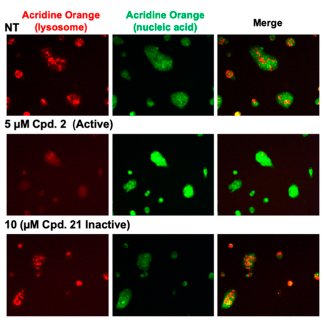Cash TP, Alcalá S, Rico-Ferreira MDR,... Sainz B Jr. Induction of Lysosome Membrane Permeabilization as a Therapeutic Strategy to Target Pancreatic Cancer Stem Cells.
Cancers. 2020
“Cancer stem cells have their weaknesses, and we have found one that we can exploit with already approved drugs”. – Dr. Bruno Sainz Anding -
Summary:
Despite significant efforts to improve pancreatic ductal adenocarcinoma (PDAC) clinical outcomes, overall survival remains dismal. The poor response to current therapies is partly due to the existence of pancreatic cancer stem cells (PaCSCs), which are efficient drivers of PDAC tumorigenesis, metastasis and relapse. To find new therapeutic agents that could efficiently kill PaCSCs, we screened a chemical library of 680 compounds for candidate small molecules with anti-CSC activity, and identified two compounds of a specific chemical series with potent activity in vitro and in vivo against patient-derived xenograft (PDX) cultures. The anti-CSC mechanism of action of this specific chemical series was found to rely on induction of lysosomal membrane permeabilization (LMP), which is likely associated with the increased lysosomal mass observed in PaCSCs. Using the well characterized LMP-inducer siramesine as a tool molecule, we show elimination of the PaCSC population in mice implanted with tumors from two PDX models. Collectively, our approach identified lysosomal disruption as a promising anti-CSC therapeutic strategy for PDAC.
Why do you highligth this publication?
In this work we have identified a class of compounds that act and eliminate pancreatic cancer stem cells, which represent the root of the tumor. The compounds have a similar mechanism of action, acting on the lysosomes of pancreatic cancer stem cells, releasing their contents and promoting the death of these cells in a CSC-specific manner. This study opens the door to the possibility of using already approved drugs, which act in a similar way, for the future treatment of pancreatic cancer.
Publication commented by:
Dr. Bruno Sainz
Instituto de Investigaciones Biomédicas "Alberto Sols" CSIC-UAM
Autónoma University of Madrid (UAM), Department of Biochemistry
Cancer stem cells and fibroinflammatory microenvironment
IRYCIS



